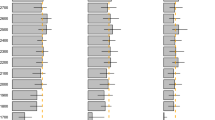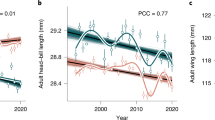Abstract
Life-history traits relating to growth and reproduction vary greatly among species and populations1,2 and among individuals within populations3. In vole populations, body size and age at maturation may vary considerably among locations and among years within the same location4,5,6,7,8. Individuals in increasing populations are typically larger and start reproduction earlier in the spring than those in declining populations6,7,8. The cause of such life-history variation within populations has been subject of much discussion7,9,10. Much of the controversy concerns whether the memory of past conditions, leading to delayed effects on life-history traits, resides in the environment (for example, predators11,12, pathogens13 or food14,15) or intrinsically within populations or individuals (age distribution16,17, physiological state3, genetic18 or maternal effects19,20). Here we report from an extensive field transplant experiment in which voles were moved before the breeding season between sites that differed in average overwintering body mass. Transplanted voles did not retain the characteristics of their source population, and we demonstrate an over-riding role of the immediate environment in shaping life-history traits of small rodents.
This is a preview of subscription content, access via your institution
Access options
Subscribe to this journal
Receive 51 print issues and online access
$199.00 per year
only $3.90 per issue
Buy this article
- Purchase on Springer Link
- Instant access to full article PDF
Prices may be subject to local taxes which are calculated during checkout




Similar content being viewed by others
References
Stearns, S. C. The Evolution of Life Histories (Oxford Univ. Press, Oxford, 1992).
Roff, D. A. The Evolution of Life Histories; Theory and Analysis (Chapman & Hall, New York, 1992).
McNamara, J. M. & Houston, A. I. State-dependent life histories. Nature 380, 215–221 (1996).
Agrell, J., Erlinge, S., Nelson, J. & Sandell, M. Body weight and population dynamics: cyclic demography in a noncyclic population of the field vole (Microtus agrestis). Can. J. Zool. 70, 494–501 (1992).
Taitt, M. J. & Krebs, C. J. in Biology of New World Microtus (ed. Tamarin, R. H.) 567–620 (American Soc. Mammalogists Special Publications No. 8, Shippensburg, 1985).
Chitty, D. Mortality among voles (Microtus agrestis) at Lake Vyrnwy, Montgomeryshire, in 1936–9. Phil. Trans. R. Soc. Lond. B 236, 505–552 (1952).
Krebs, C. J. & Myers, J. H. Population cycles in small mammals. Adv. Ecol. Res. 8, 267–399 (1974).
Tast, J. in Winter Ecology of Small Mammals (ed. Merritt, J. F.) 59–66 (Carnegie Museun of Natural History, Pittsburg, 1984).
Krebs, C. J. Population cycles revisited. J. Mamm. 77, 8–24 (1996).
Stenseth, N. C. Population cycles in voles and lemmings: density dependence and phase dependence in a stochastic world. Oikos 87, 427–461 (1999).
Korpimäki, E. & Krebs, C. J. Predation and population cycles of small mammals. BioScience 46, 754–764 (1996).
Mappes, T., Koskela, E. & Ylönen, H. Breeding suppression in voles under predation risk of small mustelids: laboratory or methodological artifact? Oikos 82, 365–369 (1998).
Soveri, T. et al. Disease patterns in field and bank vole populations during a cyclic decline in central Finland. Comp. Immunol. Microbiol. Infect. Dis. 23, 73–89 (2000).
Batzli, G. O. in Wildlife 2001: Populations (eds McCullough, D. R. & Barrett, R. H.) (Elsevier Applied Sciences, London, 1992).
Agrell, J., Erlinge, S., Nelson, J., Nilsson, C. & Persson, I. Delayed density-dependence in a small-rodent population. Proc. R. Soc. Lond. B 262, 65–70 (1995).
Boonstra, R. Population cycles in microtines: the senescence hypothesis. Evol. Ecol. 8, 196–219 (1994).
Tkadlec, E. & Zejda, J. Small rodent population fluctuations: The effects of age structure and seasonality. Evol. Ecol. 12, 191–210 (1998).
Chitty, D. The natural selection of self-regulatory behaviour in animal populations. Proc. Ecol. Soc. Aus. 2, 51–78 (1967).
Boonstra, R. & Boag, P. T. A test of the Chitty hypothesis: inheritance of life-history traits in meadow voles Microtus pennsylvanicus. Evolution 41, 929–947 (1987).
Inchausti, P. & Ginzburg, L. R. Small mammal cycles in northern Europe: patterns and evidence for maternal effect hypothesis. J. Anim. Ecol. 67, 180–194 (1998).
Lambin, X., Petty, S. J. & MacKinnon, J. L. Cyclic dynamics in field vole populations and generalist predation. J. Anim. Ecol. 69, 106–118 (2000).
Lambin, X., Elston, D., Petty, S. & MacKinnon, J. Spatial patterns and periodic travelling waves in cyclic field vole, Microtus agrestis, populations. Proc. R. Soc. Lond. B 265, 1491–1496 (1998).
Nelson, R. J. Photoperiod-nonresponsive morphs: a possible variable in microtine population-density fluctuations. Am. Nat. 130, 350–369 (1987).
Nichols, J. D. Capture recapture models; using marked animals to study population dynamics. BioScience 42, 94–102 (1992).
Lebreton, J.-D., Burnham, K. P., Clobert, J. & Anderson, D. R. Modeling survival and testing biological hypotheses using marked animals: a unified approach with case studies. Ecol. Monogr. 62, 67–118 (1992).
Burnham, K. P. & Anderson, D. R. Model Selection and Inference: a Practical Information-Theoretic Approach (Springer, New York, 1998).
Kendall, W. L., Pollock, K. H. & Brownie, C. A likelihood-based approach to capture-recapture estimation of demographic parameters under the robust design. Biometrics 51, 293–308 (1995).
Littell, R. C., Milliken, G. A., Stroup, W. W. & Wolfinger, R. D. SAS Systems for Mixed Models (SAS Institute, Cary, North Carolina, 1996).
Acknowledgements
The project was funded by grants from the Norwegian Research Council to T.E. and by the Natural Environment Research Council (UK) to X.L. We thank the Forestry Commission for support; C. Griffin and J. Aars for assistance during the transplant; and R. Boonstra, L. Crespin, K. E. Hodges, R. A. Ims, R. Julliard, T. Klemola, P. Thompson, E. Tkadlec, H. Viljugrein and N. G. Yoccoz for constructive comments and advice.
Author information
Authors and Affiliations
Corresponding author
Supplementary information
Rights and permissions
About this article
Cite this article
Ergon, T., Lambin, X. & Stenseth, N. Life-history traits of voles in a fluctuating population respond to the immediate environment. Nature 411, 1043–1045 (2001). https://doi.org/10.1038/35082553
Received:
Accepted:
Issue Date:
DOI: https://doi.org/10.1038/35082553
This article is cited by
-
Temporal variability of carabid beetles as a function of geography, environment, and species
Theoretical Ecology (2024)
-
Life history traits of free-living bush Karoo rats (Otomys unisulcatus) in the semi-arid Succulent Karoo
Mammal Research (2022)
-
Polymorphism of winter phenotype in Siberian hamster: consecutive litters do not differ in photoresponsiveness but prolonged acclimation to long photoperiod inhibits winter molt
Frontiers in Zoology (2021)
-
Spatio-temporal trends in richness and persistence of bacterial communities in decline-phase water vole populations
Scientific Reports (2020)
-
Do phase-dependent life history traits in cyclic voles persist in a common environment?
Oecologia (2019)
Comments
By submitting a comment you agree to abide by our Terms and Community Guidelines. If you find something abusive or that does not comply with our terms or guidelines please flag it as inappropriate.



